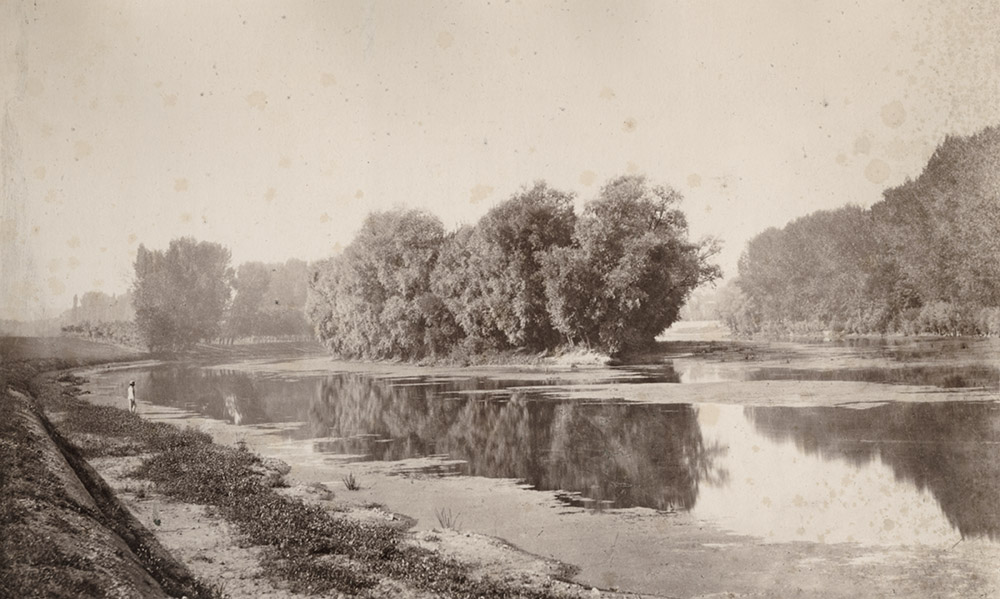
Entrée du Pré Catelan, Bois de Boulogne
Sale
$4,000

Étude des fleuves et des arbres, Bois de Boulogne
Sale
$2,000

Extérieur de la Loge Impériale au Théâtre des Fleurs, Pré Catelan, Bois de Boulogne
Sale
$2,000

Grille du Pré Catelan, Bois de Boulogne
Sale
$1,600

Reims, West Facade of Cathedral, 1854
Born on July 17, 1813 in Paris, Charles François Bossu later took the name Charles Marville as his pseudonym to avoid the teasing of his classmates over Bossu, which means hunchback. Although he made photographs throughout France, Germany and Italy, it was his native city of Paris that clearly provided the artist with his greatest and most enduring source of inspiration; and ultimately that work made his reputation as a documentary photographer—perhaps THE documentary photographer of the 19th-century. Only Eugene Atget would rival Marville's efforts to picture his beloved City of Lights, and Atget was many decades too late to document the major changes to the city under Napoleon III and Baron Georges-Eugène Haussmann.
Marville began his career as a draftsman and a painter making wood engravings and lithographs. He achieved some success as a book and magazine illustrator early in his career. He first worked as an illustrator in the medium of wood-engraving and was associated with Tony Johannot. With the writer Charles Nodier (1780–1844) and publishers, such as Curmer and Bourdin, he took part in the creation of great Romantic illustrated editions of such works as Paul et Virginie by Bernardin de Saint-Pierre. He was at this time, however, primarily a landscape artist known as an illustrator of travel books.
Marville took up photography around 1850, at first working with paper negatives and salt prints. By 1851 he was working for the Louvre Museum in Paris as its official photographer. This helped him to expand his practice by homing in on two lucrative areas: reproductions of artworks (including a significant body of work by the French painter and draughtsman Jean-Dominique Ingres) and architectural photographs.
Collaborating with architects and planners, such as Paul Abadie, Eugène Viollet-le-Duc and Felix Duban, Marville photographed the different stages of construction or of restoration of civil and religious monuments. It is this work that may have later brought Marville to the attention of Baron Haussmann. His resulting images were often then printed and distributed by the publisher Louis Désiré Blanquart-Évrard. Approximately 100 of Marville's earlier works were included in the very scarce folios and albums produced by Blanquart-Évrard.
After experimenting with collodion glass negatives by taking a series of cloud studies from his studio rooftop about 1855, Marville would continue to work with this glass wet-plate collodion negative process and produce sharper, cleaner albumen prints for his major documentary projects in the future. For these innovative cloud studies that required a more sensitive and rapid process, Marville later received much critical acclaim after showing the work at the 1862 Universal Exhibition in London.
His entrepreneurial spirit manifested itself in his development of a portable case for glass negatives and the patenting, along with a collaborator, of a stereoscopic camera.
In 1858, Marville was commissioned by the City of Paris to photograph the refurbished Bois de Boulogne, a royal park on the edge of Paris that had been transformed under the emperor Napoleon III into a site of bourgeois leisure and pleasure. Arguably his first important body of work that was conceived of and executed as a systematic series, the Bois de Boulogne group would influence his best-known work, the photographs of Old Paris. By 1862 he was the official photographer of Paris.
Commissioned in perhaps 1864 by the Paris agency on historic works (under the aegis of urban planner Georges-Eugène Haussmann), Marville made approximately 425 photographs of the narrow streets and crumbling buildings of the old city at the very moment they were threatened by demolition. Known as the "Album du Vieux Paris," the photographs of Paris' architecture and streets scenes were often taken just after it was raining, so that the soft diffused light mixed with the rain on the cobblestones to produce a picturesque image.
A decade later he returned to the same localities to photograph the new roads and "improvements". Marville did a series on the kiosks, pissoirs, parks, decorative ironwork and gas lights along the new streets of Paris that may be as remarkable as his earlier images of Paris streets prior to "modernization" by Haussmann.
As National Gallery of Art Curator, Sarah Greenough put it, "Taken as a whole, Marville’s photographs of Paris stand as one of the earliest and most powerful explorations of urban transformation on a grand scale."
By the time of his death though on June 1, 1879 in Paris, Marville had fallen into relative obscurity. Sadly not a single obituary was published in the Parisian press upon his passing. Armand Guérinet bought his studio after his death. Much of his work was stored simply in municipal or state archives. While a pair of Paris exhibits in the early 1980s resurrected Marville's reputation, a traveling exhibition recently produced by the National Gallery of Art (Washington D.C.) on the occasion of the bicentennial of Marville's birth has done much to restore his rightful place in the photographic hierarchy, while revealing new details about Marville's life.
Major repositories of Marville's work can be found in collections at the George Eastman House, the New York Metropolitan Museum of Art, the New York Museum of Modern Art, the Musée Carnavalet (Paris), the State Library of Victoria (Melbourne), Bibliothèque de la Ville (Paris), and the Bibliotheque Nationale de France--among other institutions and private collections. Many of his negatives are housed in the Bibliothèque Historique de la Ville de Paris.
Exhibited and Sold By
Contemporary Works / Vintage Works, Ltd.
258 Inverness Circle
Chalfont, Pennsylvania 18914 USA
Contact Alex Novak and Marthe Smith
Email info@vintageworks.net
Phone +1-215-518-6962
Call for an Appointment










Share This